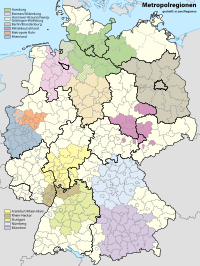Central German Metropolitan Region
Central German Metropolitan Region | |
|---|---|
 CGMR (in red) | |
| Country | |
| States | |
| Area | |
| • Metro | 2,000 km2 (800 sq mi) |
| Population (2008)[1] | |
| • Metro | 2,400,000 |
| Time zone | UTC+1 (CET) |
| Website | http://www.region-mitteldeutschland.com/en/ |
The Central German Metropolitan Region (German: Metropolregion Mitteldeutschland) is one of the so-called metropolitan regions in Germany. It is centered on the major cities of Leipzig and Halle, extending over Central German parts of the states of Saxony-Anhalt, Thuringia and Saxony. The Central German metropolitan region is the only one entirely located within the new states of Germany.
It is not actually a metropolitan area in the geographic sense of the word as an agglomeration of nearby urban areas, rather it is a loose affiliation of towns and cities whose representatives vote upon new members.[2] For example, Jena joined the Metropolitan Region in 2009.[3]
Cities
The largest of the seven member cities are Leipzig in Saxony and Halle (Saale) in Saxony-Anhalt.
Member cities
The member cities have changed over time[2] and the current member cities are as follows:
- Leipzig (540,000 inhabitants)
- Chemnitz (245,500)
- Halle (Saale) (233,000)
- Jena (105,000)
- Gera (99,000)
- Zwickau (97,000)
- Dessau-Roßlau (87,000)
- Lutherstadt Wittenberg (46,000)
Except for Zwickau and Wittenberg, all towns hold the status of an independent city. Dresden and Magdeburg are no longer part of the organization. The surrounding catchment areas officially are not part of the metropolitan region, though generally added[by whom?] for statistical and practical purposes.
Demographics
All towns and cities suffered population decrease after German reunification, however in recent years the populations of Leipzig and Halle have been increasing again. Other urban areas, such as Dessau-Roslau are however still declining.[4][5]
Gallery
-
Leipzig is the heart of the Central German Metropolitan Region and ranked 39th globally out of 289 cities for innovation in the 4th Innovation Cities Index published by Australian agency 2thinknow. Leipzig is nicknamed as the "Boomtown of eastern Germany" or "Hypezig".
-
Halle (Saale), biggest city in Saxony-Anhalt and seat of the Martin Luther University of Halle-Wittenberg.
-
View over Chemnitz. The city is among the top ten German cities in terms of economic growth rate.
-
Gera market
-
View over Wittenberg
-
Leipzig City Tunnel forms the centerpiece of an extensive S-Bahn network serving 1.2 million people in the Leipzig/Halle metropolitan area.
References
- ^ Deutsche-metropolregionen.org (PDF), BBR, Monitoring-Bericht 2010. Retrieved 6 September 2011. [dead link]
- ^ a b http://www.region-mitteldeutschland.com/en/organisation/history/ Archived August 20, 2013, at the Wayback Machine
- ^ http://www.region-mitteldeutschland.com/organisation/historie/ Retrieved 4 October 2014. Archived October 6, 2014, at the Wayback Machine
- ^ http://www.dessau.de/downloads/Deutsch/Wahlen-und-Statistik/Statistik/Statistische-Berichte/falt2012.pdf (PDF) Retrieved 4 October 2014.
- ^ http://www.economist.com/news/international/21652314-growing-number-cities-will-have-plan-drastically-smaller-populations-rus







